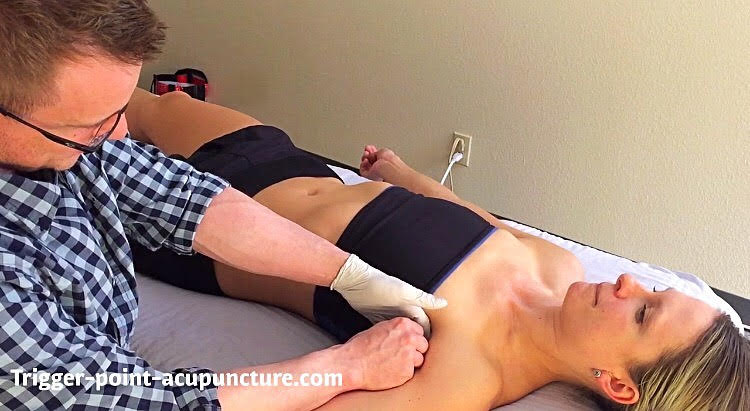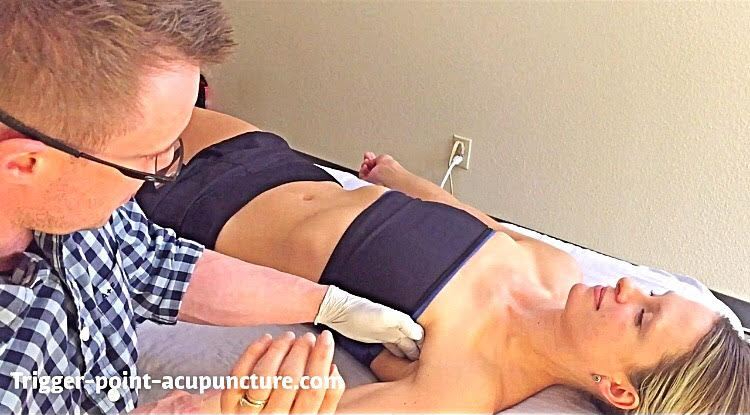When it comes to trigger point needling in the shoulder one of the major muscles we have to address is subscapularis. It plays a unique role as the only rotator cuff muscle to perform internal rotation. It is also notoriously uncomfortable to access. In my days as a massage therapist, I found it was in a similar class to the psoas in the fact that even in seemingly healthy muscle, it is very sensitive. When it comes to needling, it takes significant skill to safely needle. Please see this video for how I like to needle subscapularis!

In our advanced shoulder course, we teach how to treat subscapularis and the first aspect we discuss is the risk to reward. The risk of needling any trigger point should not exceed the reward of it being released. With confident palpation, accurate needling skills, and proper training, the risk of needling subscapularis decreases, and the reward increases. If these skills are not present, the risks can include pneumothorax, nerve damage, or artery puncture. If someone is untrained or uncomfortable with needling subscapularis, we encourage using manual therapy to treat the local trigger points. If you are interested in some of our favorite manual therapy techniques, check out last week’s blog!
Palpation

In my opinion, the most important tool to confidently needling subscapularis is manual muscle testing. As mentioned above, the subscapularis performs internal rotation. When palpating what is believed to be subscapularis, resisting internal rotation can help confidently identify the muscle. I like to ask the patient to push their wrist to the belly button as a cue (check this out in my video). Another tip is to identify other easy to find landmarks such as intercostals, latissimus dorsi, and the lateral border of the scapula. Once the lateral border of the scapula is located it is simple to find the way to the subscapular fossa. If you know all your surrounding structures, it becomes much easier to find any muscle you attempting to palpate.
Trigger points
As shown in the picture below, the trigger points in subscapularis refer to the posterior shoulder and arm as well as the anterior and posterior wrist. Under palpation is often easy to illicit a clear referral pattern.

When to treat
Deciding when to treat subscapularis is not always as straightforward as other trigger points acupuncturists treat. With a muscle like the upper trapezius, a trigger point can be palpated and safely released on a patient. In the case of the subscapularis, many factors can get in the way. Frozen shoulder is a great example. It can be a major relieving factor to needle these trigger points for decreased range of motion, but the patient needs to have the range of motion to allow access. Manual therapy can help achieve access to this area. The axilla is also a common area for patient’s to be ticklish. This is usually easily overcome by the use of a glove and quick firm pressure. I would say comfortable patient placement with safe access is an absolute must. For me, I prefer to needle subscapularis in a supine position with the patient in abduction as seen in the video.
Some common indications for needling the subscapularis can be:
- Frozen shoulder
- Decreased internal rotation
- Posterior shoulder pain
- Difficulty with putting a bra on (don’t forget Lats and Teres Major!)
Homecare for subscapularis
Homecare for subscapularis is dependent on movement and orthopedic assessment. Sometimes internal rotation with a resistance band is appropriate, but often there is more to it than that. For example, in the case of SICK Scapula, focusing on corrective exercises for the tipping of the scapula and its accompanying dyskinesis may prove more useful than direct strengthening to the subscapularis. Some of the most basic shoulder exercises I like can be found in the Trigger Point Acupuncture Facebook group or in this video. Another great tool that can be incorporated is Kinesiotape. To see an easy and effective taping method, check this video out! Just because we are using home care to treat other muscles doesn’t mean that Subscapularis won’t be indicated for needling. It is simply that we have to treat the whole pattern, versus just a single muscle….however, that is nothing new to an acupuncturist, we always treat the pattern!
If you enjoyed this post please subscribe! And remember the above is for educational purposes only. Online reading and videos are not a substitute for in-person training by a qualified professional. The author is not responsible for your actions should you use anything in the above article.

